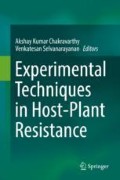Abstract
The electroantennogram (EAG) technique for recording olfactory responses of an insect to plant volatiles has been described in this chapter. The procedure is useful in detecting the plant chemicals to which the insects respond positively or negatively.
Access this chapter
Tax calculation will be finalised at checkout
Purchases are for personal use only
References
Aguirre Lina, M., Sar, C., Miles John, W., & Guillermo, S. (2012). Characterization of resistance to adult spittlebugs (Hemiptera: Cercopidae) in Brachiaria spp., Journal of economic entomology, 106(4), 1871–1877. BioOne Publisher.
Downing, N., & Unwin, D. M. (1977). A new method for cutting the mouth parts of feeding aphids, and for collecting the plant sap. Physiological Entomology, 2, 275–277.
Hamilton, R. J., Munro, J., & Rowe, J. M. (1978). Continuous rearing of Oscinella frit L. and the interaction of O. frit with Avena sativa. Entomologia Experimentalis et Applicata, 24(3), 382–386 Wiley Online Library.
Walker, G. P., & Janssen, J. A. M. (2000). Electronic recording of whitefly (Homoptera: Aleyrodidae) feeding and oviposition behaviour, Principles and applications of electronic monitoring and other techniques in the study of homopteran feeding behavior (pp. 172–200). Lanham: Thomas Say Publications in Entomology, Entomological Society of America.
Further Reading
Kogan, M. (1974). Plant resistance in pest management. In R. L Metcalf & W. L. Luckmann (Eds.), Introduction to insect pest management (pp. 103–146, p. 585). New York: A Wiley – Interscience Publications. Wiley.
Panda, N., & Kush, G. S. (1995). Host plant resistance to insects (p. 431). Wallingford: CAB International.
Phillips, W. N. (1977). Modification of feeding preference in the flea beetle, Haltica lythri (Coleoptera: Chrysomelidae). Entomologia Experimentalis et Applicata, 21, 71–80.
Viser, J. H., & Nilson, J. K. (1977). Specificity in the olfactory orientation of the Colorado beetle, Leptinotarsa decemlineata. Entomologia Experimentalis et Applicata, 21, 14–22.
Acknowledgment
The authors would like to thank authorities of Central Institute for Cotton Research, Maharashtra, and College of Horticulture, Kolar, for their encouragement and support.
Author information
Authors and Affiliations
Editor information
Editors and Affiliations
Rights and permissions
Copyright information
© 2019 Springer Nature Singapore Pte Ltd.
About this chapter
Cite this chapter
Madhu, T.N., Doddabasappa, B. (2019). Electroantennogram for Recording Olfactory Responses of an Insect to Plant Volatiles. In: Kumar Chakravarthy, A., Selvanarayanan, V. (eds) Experimental Techniques in Host-Plant Resistance. Springer, Singapore. https://doi.org/10.1007/978-981-13-2652-3_7
Download citation
DOI: https://doi.org/10.1007/978-981-13-2652-3_7
Published:
Publisher Name: Springer, Singapore
Print ISBN: 978-981-13-2651-6
Online ISBN: 978-981-13-2652-3
eBook Packages: Biomedical and Life SciencesBiomedical and Life Sciences (R0)

